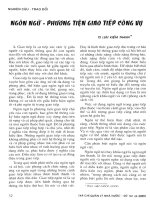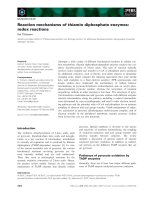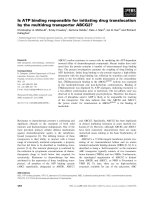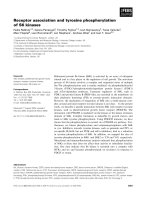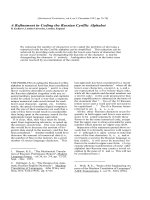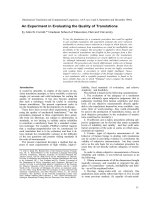Tài liệu Báo cáo khoa học: "Learning Source-Target Surface Patterns for Web-based Terminology Translation" pdf
Bạn đang xem bản rút gọn của tài liệu. Xem và tải ngay bản đầy đủ của tài liệu tại đây (152.92 KB, 4 trang )
Proceedings of the ACL Interactive Poster and Demonstration Sessions,
pages 37–40, Ann Arbor, June 2005.
c
2005 Association for Computational Linguistics
Learning Source-Target Surface Patterns for
Web-based Terminology Translation
Jian-Cheng Wu
Department of Computer Science
National Tsing Hua University
101, Kuangfu Road,
Hsinchu, 300, Taiwan
Tracy Lin
Dep. of Communication Eng.
National Chiao Tung University
1001, Ta Hsueh Road,
Hsinchu, 300, Taiwan
Jason S. Chang
Department of Computer Science
National Tsing Hua University
101, Kuangfu Road,
Hsinchu, 300, Taiwan
Abstract
This paper introduces a method for learn-
ing to find translation of a given source
term on the Web. In the approach, the
source term is used as a query and part of
patterns to retrieve and extract transla-
tions in Web pages. The method involves
using a bilingual term list to learn source-
target surface patterns. At runtime, the
given term is submitted to a search engine
then the candidate translations are ex-
tracted from the returned summaries and
subsequently ranked based on the surface
patterns, occurrence counts, and translit-
eration knowledge. We present a proto-
type called TermMine that applies the
method to translate terms. Evaluation on a
set of encyclopedia terms shows that the
method significantly outperforms the
state-of-the-art online machine translation
systems.
1 Introduction
Translation of terms has long been recognized as
the bottleneck of translation by translators. By re-
using prior translations a significant time spent in
translating terms can be saved. For many years
now, Computer-Aided Translation (CAT) tools
have been touted as very useful for productivity
and quality gains for translators. CAT tools such as
Trados typically require up-front investment to
populate multilingual terminology and translation
memory. However, such investment has proven
prohibitive for many in-house translation depart-
ments and freelancer translators and the actual
productivity gains realized have been insignificant
except for a few, very repetitive types of content.
Much more productivity gain could be achieved by
providing translation service of terminology.
Consider the job of translating a textbook such
as “Artificial Intelligence – A Modern Approach.”
The best practice is probably to start by translating
the indexes (Figure 1). It is not uncommon for
these repetitive terms to be translated once and
applied consistently throughout the book. For ex-
ample, A good translation F = "
聲學模型" for the
given term E = "acoustic model," might be avail-
able on the Web due to the common practice of
including the source terms (often in brackets, see
Figure 2) when using a translated term (e.g.
"…訓練出語音聲學模型(Acoustic Model) 及
語言模型 …"). The surface patterns of co-
occurring source and target terms (e.g., "F
(E")
can be learned by using the Web as corpus. Intui-
tively, we can submit E and F to a search engine
Figure 1. Some index entries in “Artificial intelli-
gence – A Modern Approach” page 1045.
academy award, 458
accessible, 41
accusative case, 806
Acero, A., 580, 1010
Acharya, A., 131, 994
achieves, 389
Ackley, D. H., 133, 987
acoustic model, 568
Figure 2. Examples of web page summaries with
relevant translations returned by Google for some
source terms in Figure 1.
1. 奧斯卡獎 Academy Awards. 柏林影展 Berlin International
Film Festival.
2. 有兩個「固有格位」(inherent Case),比如一個賓格
(accusative Case)、一個與
3. 有一天,當艾克禮牧師(Alfred H. Ackley) 領完佈道會之
後,有一猶太青年來問艾牧師說
4. 語音辨識首先 先藉由大量的語料,求取其特徵參數,訓
練出語音聲學模型(Acoustic Model)及語言模型
37
and then extract the strings beginning with F and
ending with E (or vice versa) to obtain recurring
source-target patterns. At runtime, we can submit
E as query, request specifically for target-language
web-pages. With these surface patterns, we can
then extract translation candidates Fs from the
summaries returned by the search engine. Addi-
tional information of occurrence counts and trans-
literation patterns can be taken into consideration
to rank Fs.
Table 1. Translations by the machine translation
system Google Translate and TermMine.
Terms Google Translate TermMine
academy award
*學院褒獎 奧斯卡獎
accusative case
*對格案件 賓格
Ackley
-
艾克禮
acoustic model
*音響模型 聲學模型
For instance, among many candidate translations,
we will pick the translations
"聲學模型" for "acous-
tic model
" and "艾克禮" for "Ackley, " because
they fit certain surface-target surface patterns and
appears most often in the relevant webpage sum-
maries. Furthermore, the first morpheme "
艾" in "
艾克禮"
is consistent with prior transliterations of
"A-" in "Ackley" (See Table 1).
We present a prototype system called TermMine,
that automatically extracts translation on the Web
(Section 3.3) based on surface patterns of target
translation and source term in Web pages auto-
matically learned on bilingual terms (Section 3.1).
Furthermore, we also draw on our previous work
on machine transliteration (Section 3.2) to provide
additional evidence. We evaluate TermMine on a
set of encyclopedia terms and compare the quality
of translation of TermMine (Section 4) with a
online translation system. The results seem to indi-
cate the method produce significantly better results
than previous work.
2 Related Work
There is a resurgent of interested in data-intensive
approach to machine translation, a research area
started from 1950s. Most work in the large body of
research on machine translation (Hutchins and
Somers, 1992), involves production of sentence-
by-sentence translation for a given source text. In
our work, we consider a more restricted case where
the given text is a short phrase of terminology or
proper names (e.g., “acoustic model” or “George
Bush”).
A number of systems aim to translate words and
phrases out of the sentence context. For example,
Knight and Graehl (1998) describe and evaluate a
multi-stage method for performing backwards
transliteration of Japanese names and technical
terms into English by the machine using a genera-
tive model. In addition, Koehn and Knight (2003)
show that it is reasonable to define noun phrase
translation without context as an independent MT
subtask and build a noun phrase translation subsys-
tem that improves statistical machine translation
methods.
Nagata, Saito, and Suzuki (2001) present a sys-
tem for finding English translations for a given
Japanese technical term by searching for mixed
Japanese-English texts on the Web. The method
involves locating English phrases near the given
Japanese term and scoring them based on occur-
rence counts and geometric probabilistic function
of byte distance between the source and target
terms. Kwok also implemented a term translation
system for CLIR along the same line.
Cao and Li (2002) propose a new method to
translate base noun phrases. The method involves
first using Web-based method by Nagata et al., and
if no translations are found on the Web, backing
off to a hybrid method based on dictionary and
Web-based statistics on words and context vectors.
They experimented with noun-noun NP report that
910 out of 1,000 NPs can be translated with an av-
erage precision rate of 63%.
In contrast to the previous research, we present a
system that automatically learns surface patterns
for finding translations of a given term on the Web
without using a dictionary. We exploit the conven-
tion of including the source term with the transla-
tion in the form of recurring patterns to extract
translations. Additional evident of data redundancy
and transliteration patterns is utilized to validate
translations found on the Web.
3 The TermMine System
In this section we describe a strategy for searching
the Web pages containing translations of a given
term (e.g., “Bill Clinton” or “aircraft carrier”) and
extracting translations therein. The proposed
method involves learning the surface pattern
38
knowledge (Section 3.1) necessary for locating
translations. A transliteration model automatically
trained on a list of proper name and transliterations
(Section 3.2) is also utilized to evaluate and select
transliterations for proper-name terms. These
knowledge sources are used in concert to search,
rank, and extract translations (Section 3.3).
3.1
Source and Target Surface patterns
With a set of terms and translations, we can learn
the co-occurring patterns of a source term E and its
translation F following the procedure below:
(1) Submit a conjunctive query (i.e. E AND F) for
each pair (E, F) in a bilingual term list to a
search engine.
(2) Tokenize the retrieved summaries into three
types of tokens: I. A punctuation II. A source
word, designated with the letter "w" III. A
maximal block of target words (or characters in
the case of language without word delimiters
such as Mandarin or Japanese).
(3) Replace the tokens for E’s instances with the
symbol “E” and the type-III token containing
the translation F with the symbol “F”. Note the
token denoted as “F” is a maximal string cover-
ing the given translation but containing no
punctuations or words in the source language.
(4) Calculate the distance between E and F by
counting the number of tokens in between.
(5) Extract the strings of tokens from E to F (or the
other way around) within a maximum distance
of d (d is set to 3) to produce ranked surface
patterns P.
For instance, with the source-target pair ("Califor-
nia," "加州") and a retrieved summary of " 亞州
簡介. 北加州 Northern California. ," the surface
pattern "FwE" of distance 1 will be derived.
3.2
Transliteration Model
TermMine also relies on a machine transliteration
model (Lin, Wu and Chang 2004) to confirm the
transliteration of proper names. We use a list of
names and transliterations to estimate the translit-
eration probability function P(
τ
|
ω
), for any given
transliteration unit (TU)
ω
and transliteration char-
acter (TC)
τ
. Based on the Expectation Maximiza-
tion (EM) algorithm. A TU for an English name
can be a syllable or consonants which corresponds
to a character in the target transliteration. Table 2
shows some examples of sub-lexical alignment
between proper names and transliterations.
Table 2. Examples of aligned transliteration units.
Name transliteration Viterbi alignment
Spagna
斯帕尼亞 s-斯 pag-帕 n-尼 a-亞
Kohn
孔恩 Koh-孔 n-恩
Nayyar
納雅 Nay-納 yar-雅
Rivard
里瓦德 ri-里 var-瓦 d-德
Hall
霍爾 ha-霍 ll-爾
Kalam
卡藍 ka-卡 lam-藍
Figure 3. Transliteration probability trained on
1,800 bilingual names (λ denotes an empty string).
τ
ω
P(
τ
|
ω
)
τ
ω
P(
τ
|
ω
)
τ
ω
P(
τ
|
ω
)
亞
.458
b
布
.700
ye
耶
.667
阿
.271
λ
.133
葉
.333
艾
.059
伯
.033
z
茲
.476
a
λ
.051
柏
.033
λ
.286
安
.923
an
安
.923
士
.095
an
恩
.077
恩
.077
芝
.048
3.3 Finding and locating translations
At runtime, TermMine follows the following steps
to translate a given term E:
(1) Webpage retrieval. The term E is submitted to
a Web search engine with the language option
set to the target language to obtain a set of
summaries.
(2) Matching patterns against summaries. The
surface patterns P learned in the training phase
are applied to match E in the tokenized summa-
ries, to extract a token that matches the F sym-
bol in the pattern.
(3) Generating candidates. We take the distinct
substrings C of all matched Fs as the candidates.
(4) Ranking candidates. We evaluate and select
translation candidates by using both data re-
dundancy and the transliteration model. Candi-
dates with a count or transliteration probability
lower than empirically determined thresholds
are discarded.
I. Data redundancy. We rank translation candi-
dates by numbers of instances it appeared in the
retrieved summaries.
II. Transliteration Model. For upper-case E, we
assume E is a proper name and evaluate each
candidate translation C by the likelihood of C as
the transliteration of E using the transliteration
model described in (Lin, Wu and Chang 2004).
39
Figure 4. The distribution of distances between
source and target terms in Web pages.
0
1000
2000
3000
4000
5000
Distance
Count
Count
63 111 369 2182 4961 2252 718 91 34
-4 -3 -2 -1 0 1 2 3 4
Figure 5. The distribution of distances between
source and target terms in Web pages.
Pattern Count Acc. Percent Example distance
FE 3036 28.1%
亞特拉斯 ATLAS
0
EF 1925 45.9%
Elton John 艾爾頓強
0
E(F 1485 59.7%
Austria(奧地利
-1
F(E
1251 71.2%
亞特拉斯(Atlas
1
F(E 361 74.6%
亞特拉斯(Atlas
1
F.E 203 76.5%
Peter Pan. 小飛俠
1
EwF 197 78.3%
加州 Northern California
-1
E,F 153 79.7%
Mexico, 墨西哥
-1
F》(E
137 81.0%
鐵達尼號》(Titanic
2
F」(E
119 82.1%
亞特拉斯」(Atlas
2
(5) Expanding the tentative translation. Based
on a heuristics proposed by Smadja (1991) to
expand bigrams to full collocations, we extend
the top-ranking candidate with count n on both
sides, while keeping the count greater than n/2
(empirically determined). Note that the con-
stant n is set to 10 in the experiment described
in Section 4.
(6) Final ranking. Rank the expanded versions of
candidates by occurrence count and output the
ranked list.
4 Experimental results
We took the answers of the first 215 questions on a
quiz Website (
www.quiz-zone.co.uk) and hand-
translations as the training data to obtain a of sur-
face patterns. For all but 17 source terms, we are
able to find at least 3 instances of co-occurring of
source term and translation. Figure 4 shows distri-
bution of the distances between co-occurring
source and target terms. The distances tend to con-
centrate between - 3 and + 3 (10,680 out of 12,398
instances, or 86%). The 212 surface patterns ob-
tained from these 10,860 instances, have a very
skew distribution with the ten most frequent sur-
face patterns accounting for 82% of the cases (see
Figure 5). In addition to source-target surface pat-
terns, we also trained a transliteration model (see
Figure 3) on 1,800 bilingual proper names appear-
ing in Taiwanese editions of Scientific American
magazine.
Test results on a set of 300 randomly selected
proper names and technical terms from Encyclope-
dia Britannica indicate that TermMine produces
300 top-ranking answers, of which 263 is the exact
translations (86%) and 293 contain the answer key
(98%). In comparison, the online machine transla-
tion service, Google translate produces only 156
translations in full, with 103 (34%) matching the
answer key exactly, and 145 (48%) containing the
answer key.
5 Conclusion
We present a novel Web-based, data-intensive ap-
proach to terminology translation from English to
Mandarin Chinese. Experimental results and con-
trastive evaluation indicate significant improve-
ment over previous work and a state-of-sate
commercial MT system.
References
Y. Cao and H. Li. (2002). Base Noun Phrase Translation Us-
ing Web Data and the EM Algorithm, In Proc. of COLING
2002, pp.127-133.
W. Hutchins and H. Somers. (1992). An Introduction to Ma-
chine Translation. Academic Press.
K. Knight, J. Graehl. (1998). Machine Transliteration. In
Journal of Computational Linguistics 24(4), pp.599-612.
P. Koehn, K. Knight. (2003). Feature-Rich Statistical Transla-
tion of Noun Phrases. In Proc. of ACL 2003, pp.311-318.
K. L. Kwok, The Chinet system. (2004). (personal
communication).
T. Lin, J.C. Wu, J. S. Chang. (2004). Extraction of Name and
Transliteration in Monolingual and Parallel Corpora. In
Proc. of AMTA 2004, pp.177-186.
M. Nagata, T. Saito, and K. Suzuki. (2001). Using the Web as
a bilingual dictionary. In Proc. of ACL 2001 DD-MT
Workshop, pp.95-102.
F. A. Smadja. (1991). From N-Grams to Collocations: An
Evaluation of Xtract. In Proc. of ACL 1991, pp.279-284.
40

